
VFR-CPR, FERRYING THE RETIRED RCAF MUSTANGS

Lynn, 22, prior to ferry flight, 1960. Note rank badges taped over on shoulders.
Immediately after the Mustangs were retired from RCAF service in 1958, I obtained the contract to service and fly them from their various locations across Canada to their new owners in New York. Some were sitting with active units, like mine, 403 City of Calgary Squadron, while others were in varying stages of long-term storage.
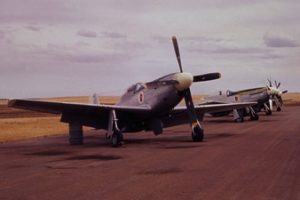
Retired 403 Squadron Mustangs awaiting ferry flights, 1961
It was an exciting time, a small period trapped like an insect in petrified amber, viewed from a distance, never to be repeated. Few were flying retired World War Two fighters then. Fewer wanted to. This would change as the years passed until, today, those unwanted aircraft command prices in the millions. One of my personal aircraft recently sold at auction for $2,556,000. I should have kept my inventory!
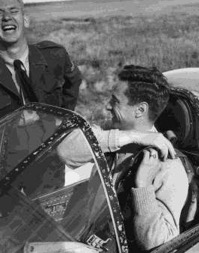
Milt Harradence
My wingman, Milt Harradence, an ex-403 pilot, who would later retire as an Appeals Court Justice in 1997, followed me, full of trust, (perhaps misplaced) as I crossed the wide open spaces of Canada flying VFR-CPR where the railroad guided us from Calgary to Lakehead, Ontario and beyond. We maintained “right hand separation” cruising along at 50 feet, with the tracks to our left, thus avoiding conflict with other aviators going the other direction. We could navigate, reading the names of towns, on grain elevators, as we roared by. Hundreds of miles, at 50 feet and 240 knots was pretty exciting!!

We had one small Skycrafters 10 channel portable radio, that worked on rare occasions. These were the days when a person could fly NORDO – No Radio – in and out of major airports, looking for a variety of light signals from the tower. Steady Green, Flashing Green, steady and flashing Red, White, all with specific meanings, now forgotten except in the pages of Wikipedia.
Read more
The first aircraft were flown onto Syracuse’s international airport. When this proved too public a destination, the Americans purchased Canastota Airport, a small private field, just east of Syracuse on the freeway system. The Mustangs were fed onto its 1800 x 50 tar macadam strip, with varying levels of success.
There wasn’t much room for error.
On one flight, my engine failed on final approach, wheels and flaps down. Expecting a powered final, I was forced to commit a Cardinal Sin… stretching a glide. I was lucky, arriving over the button in the three-point attitude, on the stall…. A “greaser”… then rolling to a stop in 750 feet, without braking.
A few days later, July 27, 1960, I experienced a more severe problem. The ’51 in question suffered a hydraulic and radio failure, along with an overheat condition….all in a short, thirty minute flight from the storage site at RCAF Station Picton, Ontario, to Canastota. Each of these flights was initiated with minimal fuel and ended with a landing on the less than satisfactory strip.
With hydraulics gone, you have no flaps but can pull the emergency undercarriage release, allowing the gear to fall under its own weight. Hopefully, it would lock down, but there was no guarantee of this. Canastota made any attempt at a flapless landing suicidal. I had already tried this art form, ending up careening into the cornfield, bordering the airport.
I contemplated alternatives as I circled above the small field. One eye on the fuel gauge and coolant temps…
There wasn’t enough fuel to divert elsewhere without radio communications and the rapidly rising coolant temperature would soon result in a loss of my ethylene glycol.
I lacked time to cope with a partial lowering of the gear.
I could bale out over Lake Erie, but that is so final.
I decided to put the aircraft down, wheels-up, under control, while I still had power.
Tugging vigorously on the tightening tabs, I snugged lap and shoulder harness to the point of discomfort, then cranked the canopy open, ducking slightly to allow its leading edge to pass over my head as it moved back. The slipstream burbled into the cockpit and I could smell the distinctive scent of ethylene glycol, venting from my engine. All pilots, with experience on liquid cooled engines will tell you this scent brings anxiety. I was already anxious.
There was nothing left to delay me, other than a decision as to putting it down on the runway, or on the grass paralleling the strip. At the bar there had been varying opinions on this challenge. I had never resolved this problem of conflicting, second-hand opinions from guys who had never confronted this situation. There was something to say for both lines of thought, but there wasn’t time to ponder, and there was no way to ask for anyone’s ideas.

Mustang control panel
Fighter pilots make solitary decisions, often with access to communication systems that tie them to the world, outside their cockpit. On this occasion I had myself and the Mustang.
Making my solitary decision I turned final at a comfortable speed and altitude…coasting rapidly past a church steeple as the coolant started to vent from just behind the prop…streaming back to cloud my windshield. My left hand pulled the throttle back against its stop then snapped the mixture upwards into Idle Cut Off, severing the fuel supply.
There was no turning back now!
I rolled the elevator trim back to about 17 degrees tail heavy, taking a bit of pressure off the stick.
Flashing over the edge of the field I narrowly missed decapitating a man who dashing in front of me, waving his arms. He later explained that he was trying to tell me my wheels were up…as if I didn’t know, but the thought was nice.
Another chap was standing there, taking a few shots of local aircraft, as I arrived. He captured my landing on film.
When developed, the 8mm footage showed my Mustang knifing past the perimeter fence in a nose high attitude, float for a distance, then settle gently onto the rear of the scoop… raising small puffs of dust on first contact. Moments later the prop touched the runway and could be seen rocking back and forth as the aircraft lost momentum, finally settling onto its belly, it slid to rest. That video is on Youtube.

My arrival was surprisingly smooth. Although I was eased forward into the harness…I only became aware of the deceleration during the last few yards as my feet raised from the floorboards.
For a moment I savored survival!
Then I released my harness and climbed out. The Mustang rested there. All that had come in contact with the runway was the scoop and prop. Neither wingtip was marked and the pitot tube remained untouched beneath the right wing.
One of the smoothest landings I have ever made.
9261 remained there until the following afternoon when a giant crane rumbled into position to lift it from the runway. While suspended, I popped the emergency undercarriage system and the gear dropped into position, locked down as two guys shoved out against each strut.
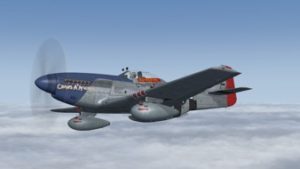
RCAF 9261 Serial Number 44-74813 is flying, in 2019, as N151BW (Bill Wiemann) “Cripes a Mighty IV”
I ferried 9281 to Canastota. It was then flown to El Salvadore, where I flew it in 1969. Jerry Janes bought it and transported the pieces to Canada where he restored it. 9281 went to David Price in Santa Monica, California as “Cottonmouth.”
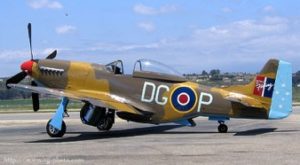
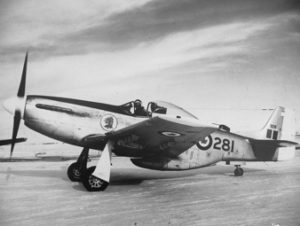
Milt Harradence and I each received a Mustang as part of the deal and mine is shown below.
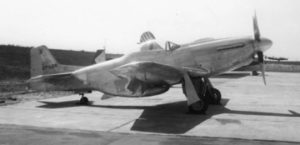
1962 my Mustang 9221 44-74435″CF-LOQ”
In 1958 James DeFuria and Fred Ritts bought all of the 78 RCAF Mustangs for something like $250,000. On the 2019 market you couldn’t find a single example for less than $1,000,000.
